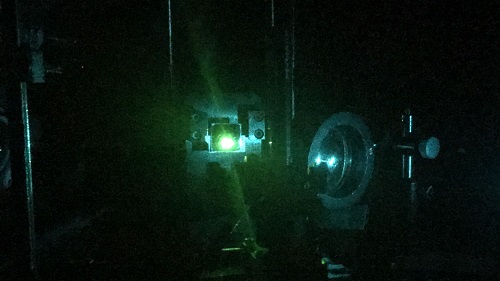
Continuous, Stable Lasing Achieved with Perovskite Laser
FUKUOKA, Japan, Sept. 8, 2020 — A team of researchers from Kyushu University in Japan and Changchun Institute of Applied Chemistry in China has demonstrated stable, continuous lasing at room temperature for over an hour using low-cost perovskites. Perovskites have been an attractive material for lasers due to their low cost, tunable colors, and high stability, though they have been prone to lasing death under continuous operation.
“The realization of lasers based on organic semiconductors has primarily been impeded by losses caused by the buildups of triplets. However, the situation for triplets in quasi-2D perovskites had yet to be fully considered,” said Chuanjiang Qin of the Changchun Institute of Applied Chemistry at the Chinese Academy of Sciences and lead researcher on the study.

A layer of perovskite is shown lasing green under continuous operation at room temperature. Courtesy of Chuanjiang Qin, Changchun Institute of Applied Chemistry, Chinese Academy of Sciences.
Excitons appear when positive and negative charges come together to form an energetic state. They are frequently observed in organic semiconductors, and because of quantum mechanics considerations, most often fall into two types: termed singlets and triplets, with light emission being nearly impossible for triplets.
Finding evidence of triplet excitons with long lifetimes of nearly 1 µs in the materials, the researchers began to focus on triplets as the potential cause of lasing death.
“Triplets do not emit light and have a tendency to interact with light-emitting singlets in a way that causes both to lose their energy without producing light,” Qin said. “Thus if triplets are present in perovskites, we likely need to get them out of the way so they do not interfere with lasing.”
The researchers incorporated an organic layer into the perovskites that holds triplets in a low-energy state. Because the excitons want to move to lower energies, the long-lived triplet excitons transfer from the light-emitting portion of the perovskite to the organic layers, thereby reducing losses and allowing lasing under constant optical excitation to continue without interruption. The researchers also found that they could achieve continuous lasing by redesigning the system to expose the perovskite layer to air, as oxygen can destroy triplets, further confirming the suspicion that losses caused by triplets contribute to lasing death.
With these designs, the researchers achieved continuous operation with intensity of lasing nearly unchanged after 1 hr at room temperature in a room with a relative humidity of 55%, and lasing spectra maintaining its narrowness without shifting.
“These new findings will pave the way for the future development of a new class of electrically operated lasers based on perovskites that are low cost and easily fabricated,” Chihaya Adachi of Kyushu University’s Center for Organic Photonics and Electronics Research, and leader of the Kyushu University team, said.
The research was published in Nature (www.doi.org/10.1038/s41586-020-2621-1).
Published: September 2020